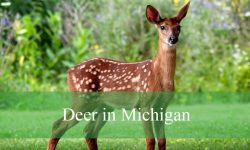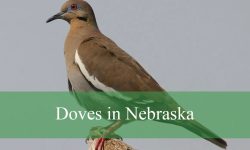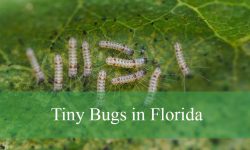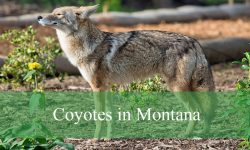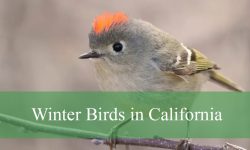Arkansas is home to a wide variety of grasshoppers, from bright green meadow species to large, strong fliers found in forests and farmlands. These insects bring color and movement to the state’s natural landscapes.
You can find them in open fields, along rural roads, and even in backyard gardens. Each species has its own color patterns, behaviors, and preferred habitat, making grasshopper watching an exciting part of exploring Arkansas’s outdoors.
This guide introduces 15 of the most common types of grasshoppers in Arkansas. It includes their identifying features, where to see them, and interesting facts that will help you recognize each one easily.
Types of Grasshoppers Found in Arkansas
Differential Grasshopper (Melanoplus differentialis)
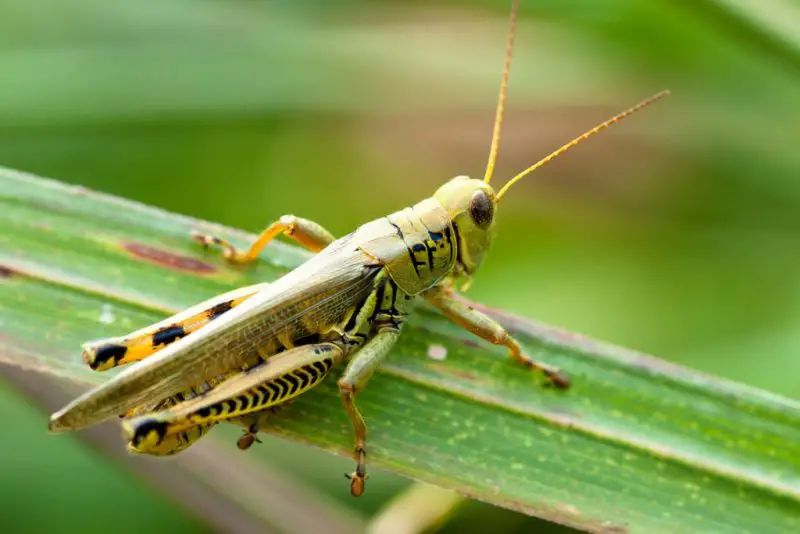
The Differential Grasshopper is one of the most recognizable and widespread grasshoppers in Arkansas. It has a yellowish-brown body with bold black herringbone patterns on its hind legs, which make it easy to identify. Adults are large, reaching up to 1.5 inches in length, with strong wings that allow them to fly short distances when disturbed.
This species thrives in grassy fields, meadows, and agricultural areas, especially in regions with abundant vegetation. It prefers open, sunny habitats where it can feed on various plants. You can often see it perched on tall weeds or crops, moving slowly before jumping away when approached.
The Differential Grasshopper is well known among farmers because it can become a serious agricultural pest. During population surges, it feeds on crops such as corn, soybeans, and alfalfa, sometimes stripping entire leaves. However, its population naturally fluctuates depending on weather and predators.
In Arkansas, these grasshoppers are most active from late spring through early fall. They mate in summer, and females deposit their eggs in the soil before winter. The eggs hatch the following spring, continuing the annual cycle that keeps this species common across the state.
Red-legged Grasshopper (Melanoplus femurrubrum)
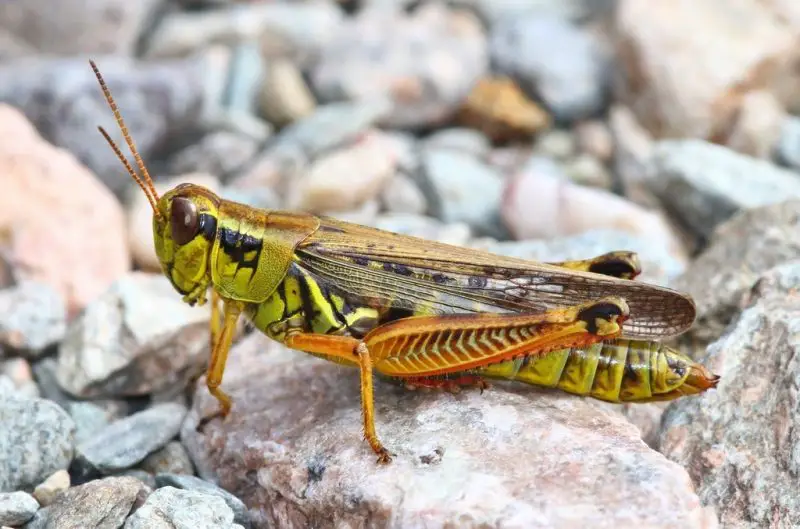
The Red-legged Grasshopper is a smaller, more delicate species that’s extremely common throughout Arkansas. Its most distinct feature is its reddish hind legs, which contrast against its brownish-green body. Adults reach about an inch long and have short, powerful wings.
You’ll often find this species in moist fields, meadows, and even backyard lawns. It favors areas with lush vegetation and plenty of grasses to feed on. Unlike some larger species, the Red-legged Grasshopper tends to be less destructive to crops, although it can still nibble on various plants during population booms.
This grasshopper plays an important ecological role as a major food source for birds, small mammals, and reptiles. It’s frequently seen hopping around during warm, sunny days and is quick to leap when approached. Its alert nature and rapid movements help it avoid many predators.
Active from spring through early fall, the Red-legged Grasshopper reproduces rapidly under warm conditions. Its adaptability and high reproductive rate make it one of the most abundant species in Arkansas, ensuring its continued presence in both rural and suburban areas.
Two-striped Grasshopper (Melanoplus bivittatus)
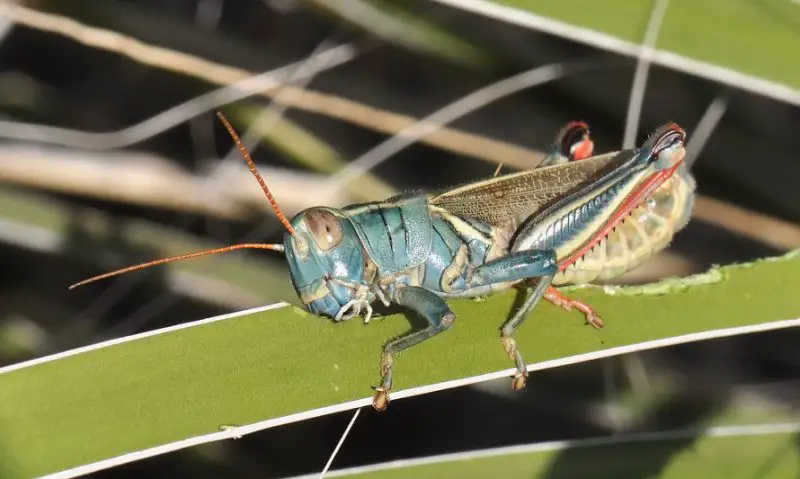
The Two-striped Grasshopper is a large and robust species known for the two pale yellow stripes running along its back from head to wing tips. This distinctive pattern, combined with its olive or brown body, makes it one of the easiest grasshoppers to identify in Arkansas. Adults typically grow up to 2 inches long.
It inhabits open fields, prairies, and agricultural regions where it feeds on grasses and broadleaf plants. The Two-striped Grasshopper is particularly common in crop-rich areas during hot summers. When disturbed, it often flies short distances with a loud fluttering sound before landing and hiding among plants.
This species is considered one of the most damaging agricultural grasshoppers in North America. It feeds on many types of crops, including corn, wheat, soybeans, and vegetables, sometimes causing widespread leaf loss. Farmers often monitor it closely during midsummer, when nymphs mature into feeding adults.
The life cycle of the Two-striped Grasshopper follows a single generation per year. Eggs are laid in the soil in late summer and hatch in spring. In Arkansas, populations peak from June through August, when warm temperatures and dry conditions favor their growth.
Carolina Grasshopper (Dissosteira carolina)
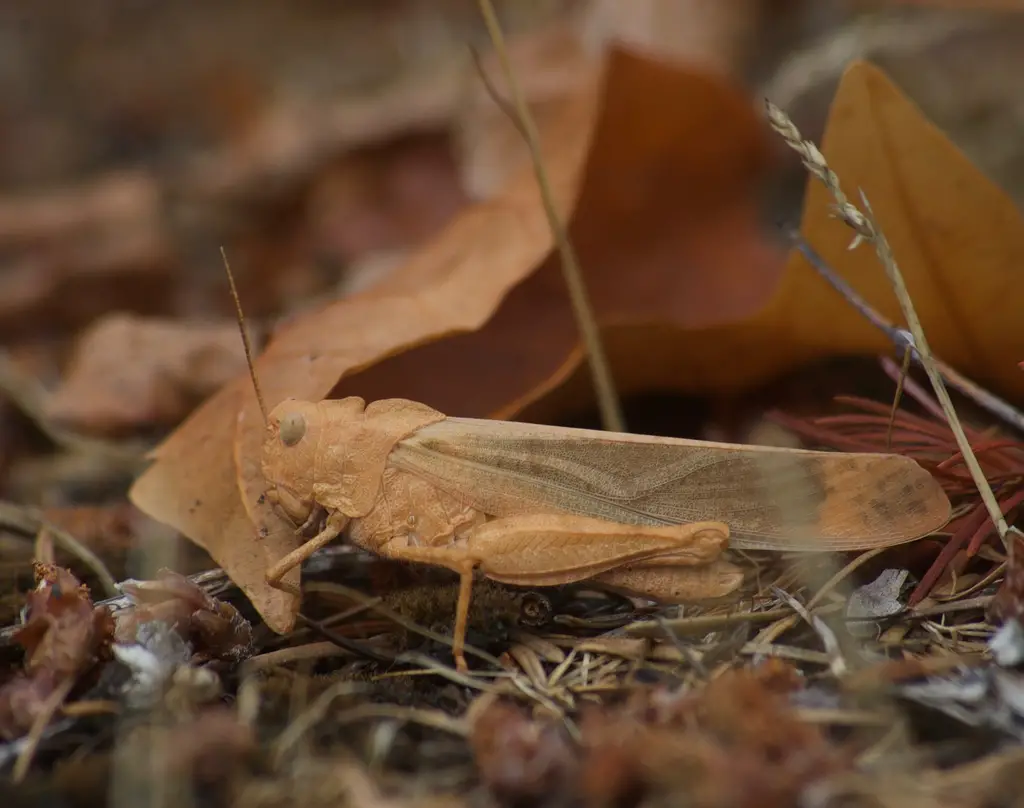
The Carolina Grasshopper, also known as the “Road-duster,” is common throughout Arkansas’s dry, open areas. It’s a large species with a gray or brown mottled body that blends well with soil and gravel. When it flies, it reveals dark hind wings edged with pale yellow — a striking display used to startle predators.
This grasshopper prefers open habitats such as dirt roads, fields, and sandy clearings. You’ll often see it resting motionless on bare ground, perfectly camouflaged. Its coloration changes slightly depending on its surroundings, allowing it to blend into almost any dry environment.
Unlike some of its relatives, the Carolina Grasshopper is not a major agricultural pest. It feeds primarily on wild grasses and weeds rather than cultivated crops. Its preference for dry, open spaces means it’s more likely to be found along rural roadsides than in farm fields.
Adults are active from midsummer through early autumn. During the hottest months, they bask on sun-warmed surfaces and take short, low flights when disturbed. Their cryptic coloration and powerful wings make them one of Arkansas’s most fascinating grasshopper species to observe in the wild.
Green-striped Grasshopper (Chortophaga viridifasciata)
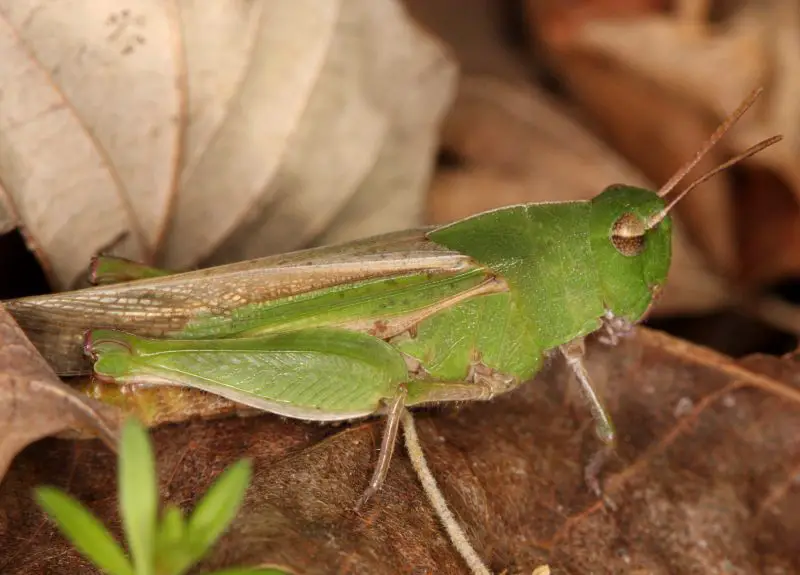
The Green-striped Grasshopper is one of the first grasshoppers to appear each year in Arkansas, often emerging as early as spring. It is medium-sized, with females typically green and males more brownish in color. The green stripe running along the back gives this species its name.
It is commonly found in grassy areas, meadows, and lawns across the state. The species prefers moist habitats but can also adapt to drier fields and open woods. When disturbed, it makes short, quick flights and lands back among the grass, where it easily disappears into the foliage.
Unlike many other species, the Green-striped Grasshopper rarely causes significant crop damage. It feeds mostly on grasses and low vegetation, contributing to natural plant control within ecosystems. Its early-season activity also provides a valuable food source for birds and small predators.
Active from March through September, this species thrives in moderate temperatures. Its adaptability, early appearance, and colorful body make it one of Arkansas’s most distinctive and easily spotted grasshoppers in spring and early summer.
Migratory Grasshopper (Melanoplus sanguinipes)
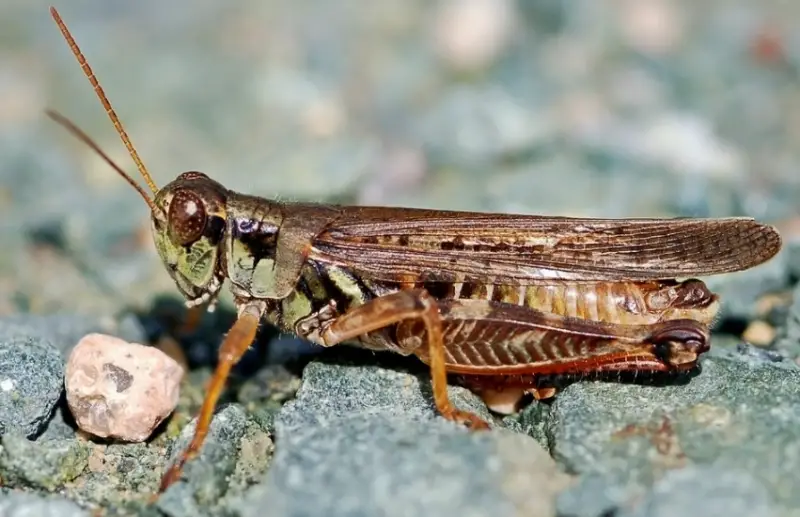
The Migratory Grasshopper is one of the most widespread and adaptable grasshopper species found in Arkansas. It has a slender brown to olive-colored body with slightly reddish hind legs and long wings. Adults measure about 1 to 1.3 inches in length, with a streamlined shape suited for flying long distances.
This species lives primarily in open grasslands, pastures, and agricultural regions. It thrives in dry, sunny environments with abundant vegetation and is often seen during mid to late summer. Because of its strong flying ability, it can move across large areas, sometimes forming localized swarms when conditions are favorable.
The Migratory Grasshopper is well known for its potential to damage crops during outbreaks. It feeds on a wide range of plants, from grasses and weeds to grains and vegetables. However, under normal population levels, it plays a valuable role as a food source for birds and small mammals in Arkansas ecosystems.
This grasshopper’s life cycle includes one generation per year. Eggs laid in late summer hatch in spring, and nymphs develop quickly in warm weather. By midsummer, adults dominate open landscapes, especially in western and northern parts of the state.
Spur-throated Grasshopper (Melanoplus angustipennis)
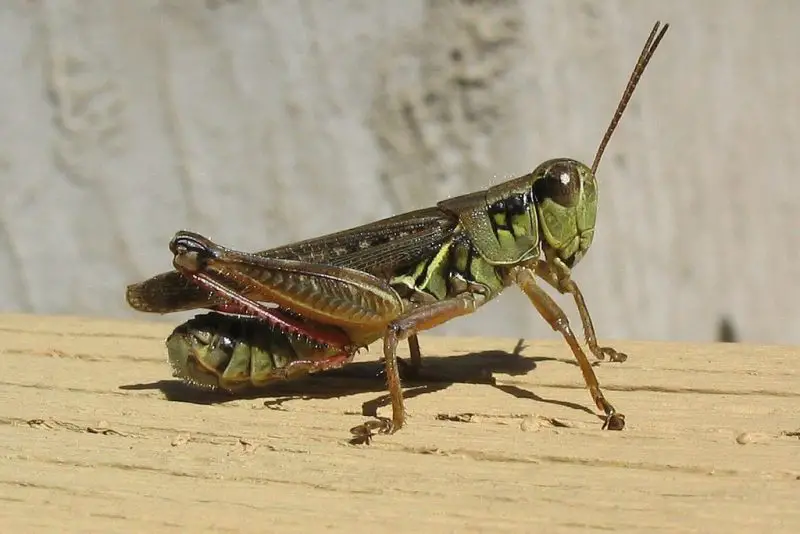
The Spur-throated Grasshopper is named for the small spine or “spur” found between its front legs — a defining feature of this group. It has a brownish body with a slightly greenish tint, and its wings extend beyond the tip of the abdomen. Adults grow about 1 inch long and have a sturdy build.
This species can be found in a variety of habitats across Arkansas, including meadows, fields, and forest edges. It prefers sunny areas with tall grasses and open ground for basking. When approached, it often flies short distances and quickly disappears into surrounding vegetation.
While not typically a pest, the Spur-throated Grasshopper feeds on grasses and herbs and contributes to the ecological balance of open landscapes. It helps control plant growth and serves as an important prey item for birds, toads, and small mammals.
Adults are most active during late summer, and females deposit eggs in the soil before winter. Its wide distribution and resilience to different habitats make it one of the more common grasshoppers across the state.
Short-winged Green Grasshopper (Dichromorpha viridis)
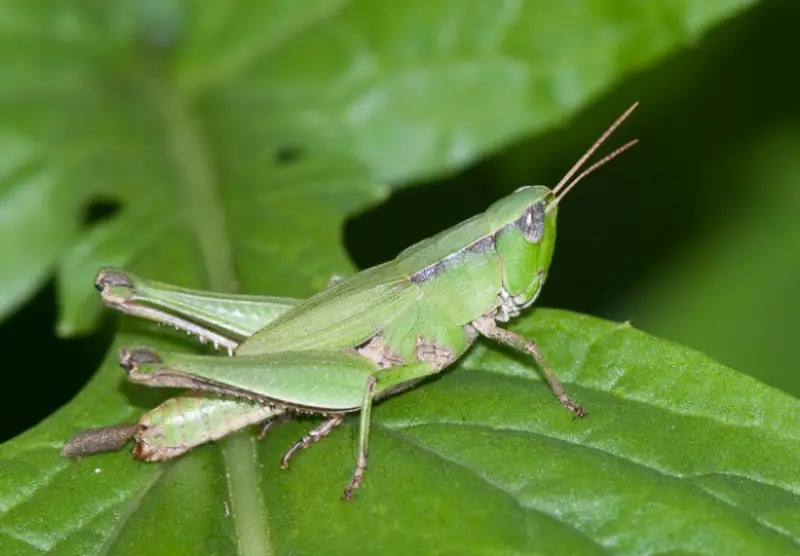
The Short-winged Green Grasshopper is a small, slender species recognized by its vivid green color and reduced wings. Females often have shorter wings than males, making them appear less capable of flight. The bright coloration provides excellent camouflage among grasses and low vegetation.
This species thrives in moist environments such as marsh edges, ditches, and damp meadows throughout Arkansas. It prefers cooler, humid conditions compared to many other grasshoppers. When disturbed, it tends to jump rather than fly, landing close to where it started.
Unlike larger species, the Short-winged Green Grasshopper poses no threat to crops. It primarily feeds on grass blades and low herbs, maintaining a modest population density that blends naturally into its environment. It is a quiet, unobtrusive species often overlooked due to its small size.
Active from late spring through summer, this grasshopper contributes to the biodiversity of wetland and meadow habitats. Its subtle beauty and gentle behavior make it an appealing species for those who enjoy observing grassland insects up close.
Obscure Bird Grasshopper (Schistocerca obscura)
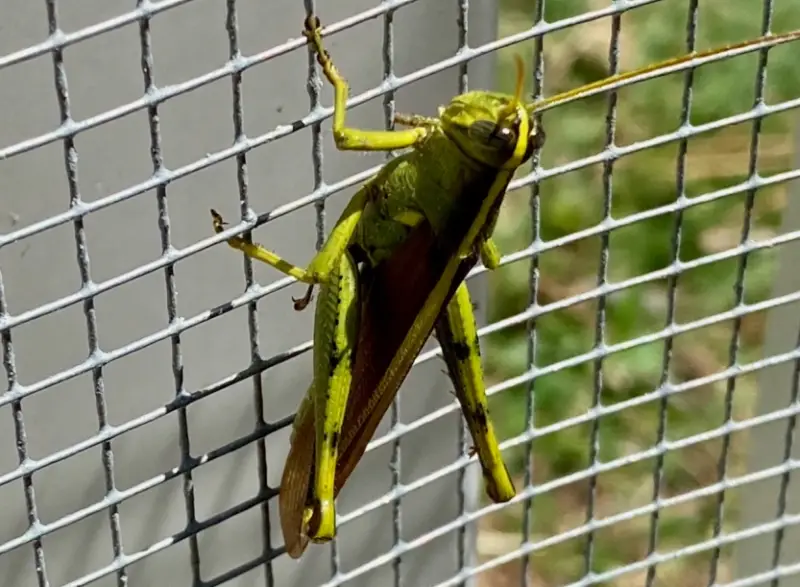
The Obscure Bird Grasshopper is a large and powerful jumper commonly found in Arkansas’s wooded and grassy areas. Adults are brown or olive-colored with lighter underwings, blending well with tree bark and vegetation. They can reach up to 2 inches in length, making them one of the larger species in the state.
This grasshopper prefers forest edges, open woodlands, and shrubby fields. It’s frequently seen perched on low branches, tree trunks, or tall grass stems. Unlike many ground-dwelling grasshoppers, it spends much of its time above the soil surface.
The Obscure Bird Grasshopper feeds on leaves from a wide variety of plants, including shrubs and trees. It rarely causes serious damage, but during peak seasons, it may defoliate some vegetation in concentrated areas. Its long, strong wings allow it to travel significant distances between feeding spots.
Active from midsummer through fall, this species is well adapted to both wooded and open landscapes. Its combination of size, camouflage, and agility makes it a fascinating sight for observers exploring Arkansas’s natural areas.
American Bird Grasshopper (Schistocerca americana)
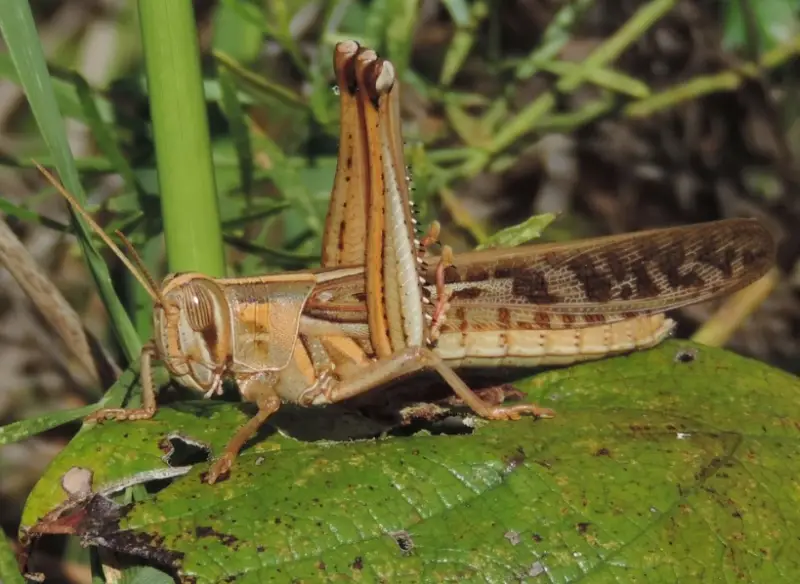
The American Bird Grasshopper is a striking and large species native to Arkansas and the broader southern United States. Adults are typically tan to brown with light yellow or cream stripes running along the back. Their size can reach over 2 inches, and they possess long wings that make them strong fliers.
This species inhabits open fields, forest edges, and agricultural lands. It’s often found resting on shrubs, tree branches, or tall grasses, where its coloration helps it blend perfectly with its surroundings. When disturbed, it can fly long distances with powerful wingbeats.
The American Bird Grasshopper is known to feed on a wide range of plants, including agricultural crops such as corn, cotton, and soybeans. Although it can become a pest during outbreaks, it’s generally not as destructive in Arkansas as in more tropical regions.
Its adaptability allows it to thrive in both rural and urban settings. Adults remain active until late fall, and their strong flight and striking appearance make them one of the most impressive grasshoppers to encounter in the state.
Pine Tree Spur-throat Grasshopper (Melanoplus punctulatus)
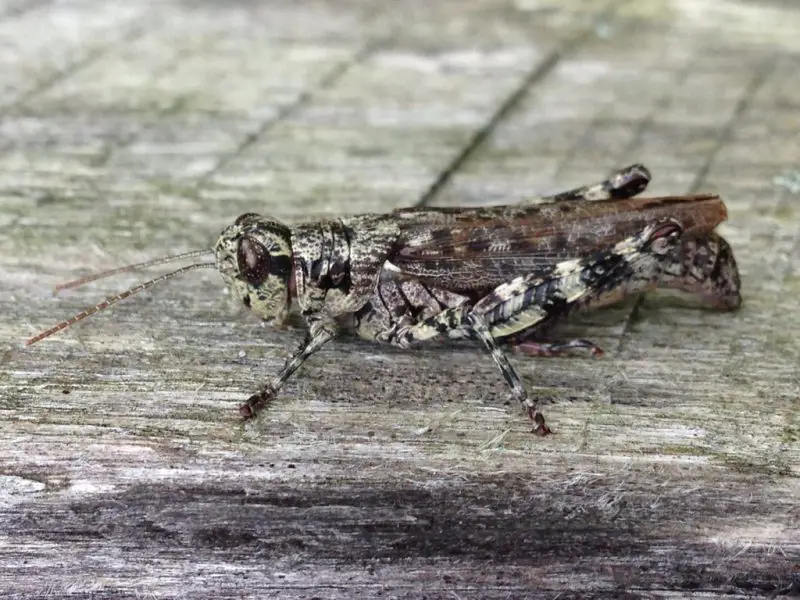
The Pine Tree Spur-throat Grasshopper is a unique species in Arkansas because of its preference for wooded habitats, particularly pine forests. Unlike most grasshoppers that inhabit open fields, this species spends much of its time on tree trunks and branches. It has a dark brown to blackish body, often mottled with gray, which helps it blend into bark surfaces.
This grasshopper is usually seen clinging vertically to tree trunks, where it remains motionless until disturbed. Its coloration serves as exceptional camouflage, allowing it to avoid predators such as birds and lizards. The adults can reach up to 1.2 inches in length and possess strong hind legs adapted for jumping from tree to tree.
The Pine Tree Spur-throat Grasshopper feeds mainly on pine needles and other woody vegetation. Because of its specialized diet and habitat, it is not considered an agricultural pest. It plays a quiet but important role in forest ecosystems, helping to recycle plant matter and provide food for forest-dwelling predators.
In Arkansas, this species is active from late spring through early fall, especially in the pine forests of the Ozark and Ouachita Mountains. Its unusual behavior and habitat preference make it one of the most distinctive grasshoppers in the region.
Autumn Yellow-winged Grasshopper (Arphia xanthoptera)
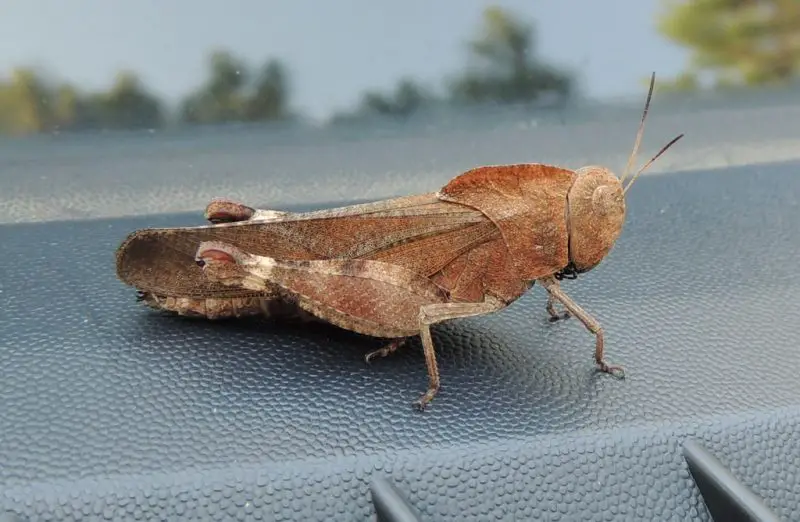
The Autumn Yellow-winged Grasshopper is a visually stunning species found throughout Arkansas. It is named for its bright yellow hind wings, which are visible only during flight. When resting, it appears cryptic with mottled brown and gray forewings that blend perfectly with dry grass or soil.
This grasshopper is most active in late summer and early autumn, often seen flying short distances over open fields, roadsides, and pastures. It prefers dry, grassy environments and can often be spotted basking on warm rocks or soil during sunny afternoons.
During flight, the sudden flash of yellow from its hind wings acts as a startle display to confuse predators. The sound of its fluttering wings is also a familiar part of Arkansas’s late-summer landscape. It feeds mainly on grasses and small herbs, rarely causing any agricultural harm.
The Autumn Yellow-winged Grasshopper contributes to the ecological balance of prairie and grassland habitats. Its bright wings and seasonal activity make it a favorite subject among insect photographers and nature enthusiasts.
Marsh Meadow Grasshopper (Pseudochorthippus curtipennis)
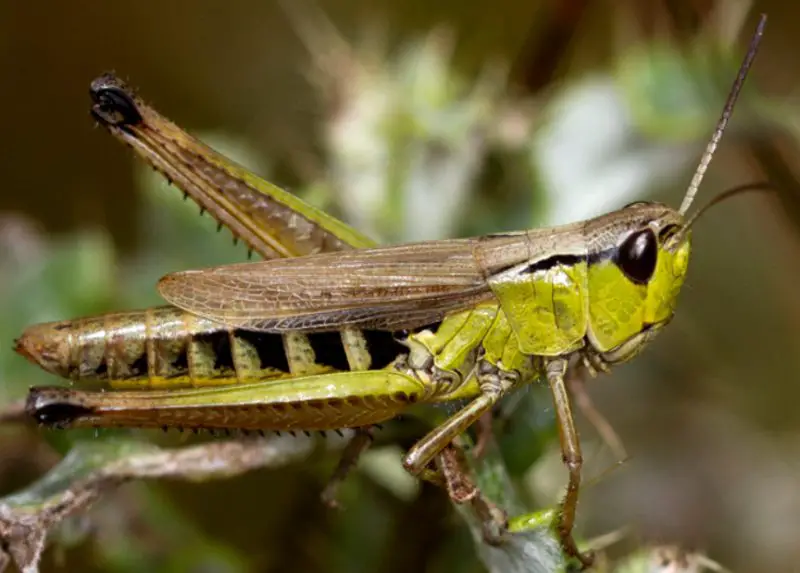
The Marsh Meadow Grasshopper is a small to medium-sized species that inhabits wet grasslands, meadows, and marshy fields throughout Arkansas. It has a slender, light brown to olive-green body with a slightly slanted face and short wings. This grasshopper typically measures about 0.8 to 1 inch long and is often mistaken for other meadow species due to its subtle coloration.
It prefers moist, grassy environments such as the edges of ponds, wetlands, and low-lying pastures. The species is well adapted to humid areas where dense vegetation provides shelter and food. Males are known for their soft, buzzing song produced during warm summer days—a familiar sound in Arkansas’s marshy meadows.
The Marsh Meadow Grasshopper feeds mainly on grasses and sedges. It rarely damages crops and instead helps maintain ecological balance in wetland ecosystems. By grazing on plant growth, it supports nutrient cycling and provides an important food source for birds, frogs, and small mammals.
Active from mid-summer through early fall, this species is most easily observed in lush, damp grasslands after rainfall. Its peaceful behavior, soft coloring, and gentle song make it one of the most charming grasshoppers to encounter in Arkansas’s natural wetlands.
Pasture Grasshopper (Melanoplus confusus)
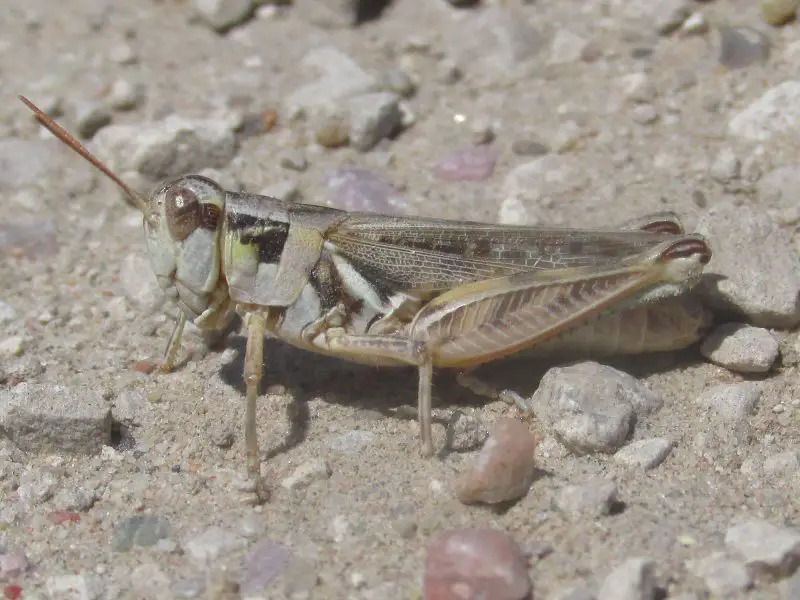
The Pasture Grasshopper is a medium-sized species commonly found in grassy fields, farmlands, and open prairies across Arkansas. It has a light brown or olive body with darker markings and relatively short wings. Adults typically measure about 1 inch long and are well suited for jumping rather than long flights.
As its name suggests, this grasshopper thrives in pastures and open grassy areas where it feeds on a variety of plants, mainly grasses and weeds. It is active throughout the warm months, especially in summer, when vegetation is abundant. You can often see it moving in small groups within dense grass.
Although it occasionally nibbles on crops, the Pasture Grasshopper is not known to cause significant damage. It coexists peacefully with other species and provides an important link in the food chain, supporting insect-eating birds and small mammals.
Its coloration blends naturally with the grassy environments it inhabits. Because of its abundance and adaptability, this grasshopper is one of the most typical species seen by hikers and farmers in Arkansas.
Sulphur-winged Grasshopper (Arphia sulphurea)
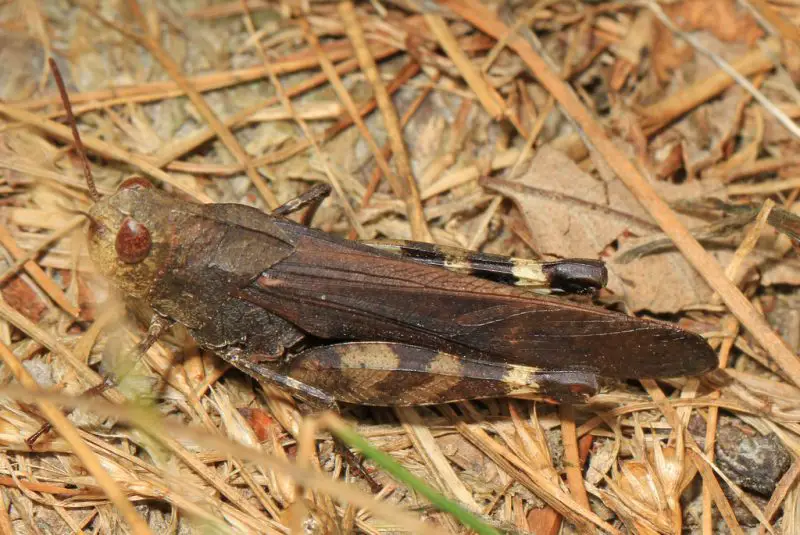
The Sulphur-winged Grasshopper is one of the most colorful and recognizable grasshoppers in Arkansas. When resting, it appears brown or gray and nearly invisible against dry ground. However, when it takes flight, it reveals brilliant yellow hind wings that flash vividly before quickly disappearing as it lands.
This species prefers dry, open grasslands, rocky hillsides, and sunny clearings. It is most active in early spring through mid-summer, often among the first grasshoppers to emerge each year. Its early activity helps it avoid competition with later-developing species.
The Sulphur-winged Grasshopper feeds on a range of grasses and herbaceous plants but is not harmful to agriculture. Its presence is usually an indicator of healthy, native grassland ecosystems. The bright wing coloration may also help in mating displays and predator evasion.
In Arkansas, this species is most easily observed during warm, sunny days from March through June. Its striking flight display and cheerful appearance make it a symbol of springtime in the state’s prairies and meadows.
Grasshopper Watching Tips in Arkansas
Arkansas’s diverse habitats—ranging from Ozark meadows to Delta farmlands—make it an ideal place to observe a wide variety of grasshoppers. These insects are most active during warm, sunny weather from late spring through early autumn. The best time to look for them is between mid-morning and late afternoon, when they are feeding or basking on plants and bare soil.
For beginners, open grasslands, roadsides, and nature trails are excellent starting points. Species such as the Green-striped Grasshopper and Differential Grasshopper are easy to find in grassy fields, while Carolina Grasshoppers often rest on dusty paths or open ground. Walk slowly and watch for sudden jumps—grasshoppers tend to leap a few feet before landing again, making them easier to follow with your eyes.
If you enjoy photography, a macro or telephoto lens will help capture close-up details like wing colors or leg patterns. Look for early morning light or golden-hour conditions for the best shots. Always move gently and avoid casting your shadow directly over the insect, as grasshoppers are sensitive to movement and quick to flee.
For a more educational experience, consider visiting nature preserves or state parks such as Hobbs State Park or Mount Magazine, where grasshopper diversity is especially high. Bring a field guide or use an insect identification app to compare different species. Observing these creatures up close not only offers a glimpse into Arkansas’s natural biodiversity but also deepens your appreciation for how small insects sustain larger ecosystems.
FAQs About Grasshoppers in Arkansas
What time of year are grasshoppers most common in Arkansas?
Grasshoppers are most abundant from June through September, when the weather is hot and dry. Some species, like the Sulphur-winged Grasshopper, appear earlier in spring.
Where can I see grasshoppers in Arkansas?
They are found almost everywhere—grasslands, farmlands, forest edges, and even city parks. Dry, sunny areas with tall vegetation are their favorite habitats.
Do grasshoppers harm crops in Arkansas?
Most species are harmless, but a few, such as the Differential and Two-striped Grasshoppers, can damage crops like corn, soybeans, and alfalfa during population peaks.
Are grasshoppers dangerous to humans?
No, grasshoppers do not bite or sting. They are completely harmless and are more likely to flee than to interact with people.
How can I tell grasshoppers apart?
Pay attention to wing color, leg markings, and habitat. For example, Arphia species show bright yellow or orange wings when flying, while Melanoplus species have striped or spurred legs.
What animals eat grasshoppers in Arkansas?
Birds, toads, snakes, lizards, and small mammals all rely on grasshoppers as a key food source, making them an essential part of the food web.
How can I attract grasshoppers for observation?
Keep areas of tall grass and native plants in your yard or garden, avoid pesticide use, and provide sunlit open spots where they can bask and feed.

